

Compact Muon Solenoid
LHC, CERN
| CMS-PAS-EXO-17-006 | ||
| Search for evidence of Type-III seesaw mechanism in multilepton final states in pp collisions at √s= 13 TeV | ||
| CMS Collaboration | ||
| March 2017 | ||
| Abstract: A search for a type-III seesaw signal in events with three or more electrons or muons is presented. The data sample corresponds to 35.9 fb−1 of integrated luminosity in pp collisions at √s= 13 TeV collected by the CMS experiment at the LHC in 2016. The signal is sought after in final states with at least three leptons, and has diverse kinematic properties. The primary selection is based on the number of leptons and the invariant mass of opposite-sign lepton pairs, and helps discriminate the signal against the standard model background. The final optimization for the type-III seesaw signal is based on the sum of leptonic transverse momenta and missing transverse energy, as well as the transverse mass. The observations are consistent with expectations from standard model processes. The results are used to exclude heavy fermions of the type-III seesaw model with masses below 850 GeV for the lepton-flavor democratic scenario. | ||
|
Links:
CDS record (PDF) ;
inSPIRE record ;
CADI line (restricted) ;
These preliminary results are superseded in this paper, PRL 119 (2017) 221802. The superseded preliminary plots can be found here. |
||
| Figures | |
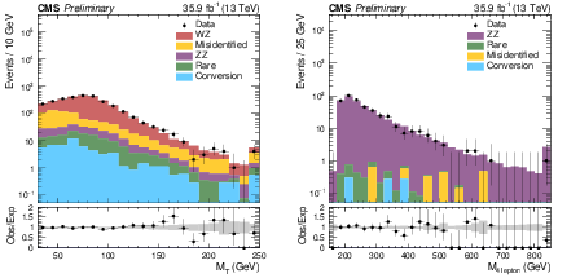
png pdf |
Figure 1:
The MT distribution in a WZ enriched selection of events with three leptons and one OSSF pair with mass on-Z, 50 <EmissT< 100 GeV and MT> 30 GeV (left), and the four-lepton invariant mass distribution in a ZZ enriched selection of events with four leptons and two OSSF pairs both of which are on-Z and EmissT< 50 GeV (right). The total SM background is shown as a stack of all contributing processes, and the gray band in the lower panel represents the statistical uncertainty on the expected background. |
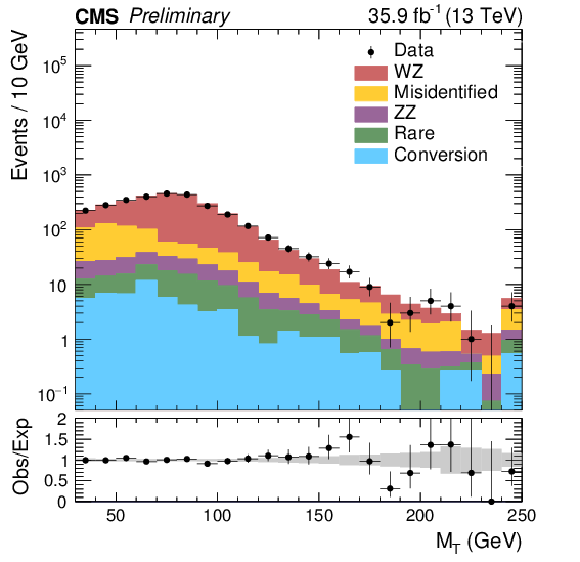
png pdf |
Figure 1-a:
The MT distribution in a WZ enriched selection of events with three leptons and one OSSF pair with mass on-Z, 50 <EmissT< 100 GeV and MT> 30 GeV. The total SM background is shown as a stack of all contributing processes, and the gray band in the lower panel represents the statistical uncertainty on the expected background. |
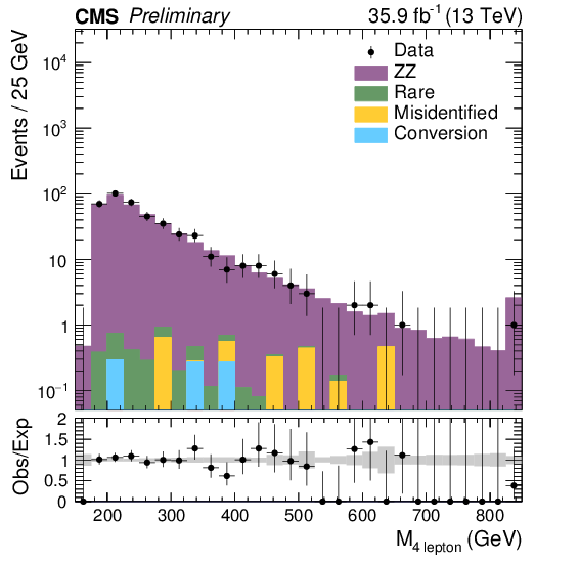
png pdf |
Figure 1-b:
The four-lepton invariant mass distribution in a ZZ enriched selection of events with four leptons and two OSSF pairs both of which are on-Z and EmissT< 50 GeV. The total SM background is shown as a stack of all contributing processes, and the gray band in the lower panel represents the statistical uncertainty on the expected background. |
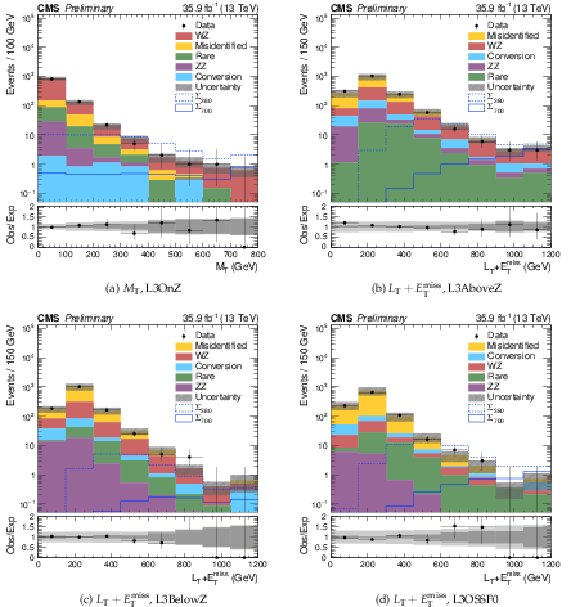
png pdf |
Figure 2:
The MT distribution for events with three leptons and one OSSF pair, with mass on-Z and EmissT> 100 GeV (top left), the LT+EmissT distribution for events with three leptons and one OSSF pair with mass above-Z (top right), the LT+EmissT distribution for events with three leptons and one OSSF pair, with mass below-Z and EmissT> 50 GeV (bottom left) and with three leptons and no OSSF pairs (below right). The total SM background is shown as a stack of all contributing processes. The predictions for signal models with mΣ= 700 GeV (solid line) and mΣ= 380 GeV (dashed line) (sum of all production and decay modes) are also shown. The hatched gray band in the upper panel, and the dark and light gray bands in the lower panel represent the total, statistical, and systematic uncertainties on the expected background, respectively. |

png pdf |
Figure 2-a:
The MT distribution for events with three leptons and one OSSF pair, with mass on-Z and EmissT> 100 GeV. The total SM background is shown as a stack of all contributing processes. The predictions for signal models with mΣ= 700 GeV (solid line) and mΣ= 380 GeV (dashed line) (sum of all production and decay modes) are also shown. The hatched gray band in the upper panel, and the dark and light gray bands in the lower panel represent the total, statistical, and systematic uncertainties on the expected background, respectively. |
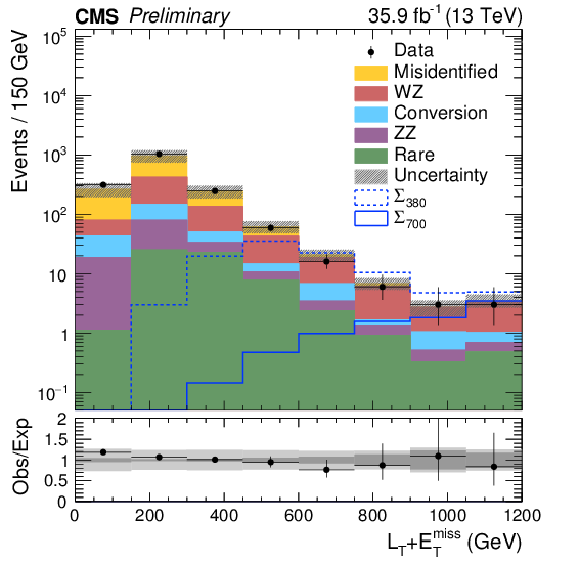
png pdf |
Figure 2-b:
The LT+EmissT distribution for events with three leptons and one OSSF pair with mass above-Z. The total SM background is shown as a stack of all contributing processes. The predictions for signal models with mΣ= 700 GeV (solid line) and mΣ= 380 GeV (dashed line) (sum of all production and decay modes) are also shown. The hatched gray band in the upper panel, and the dark and light gray bands in the lower panel represent the total, statistical, and systematic uncertainties on the expected background, respectively. |
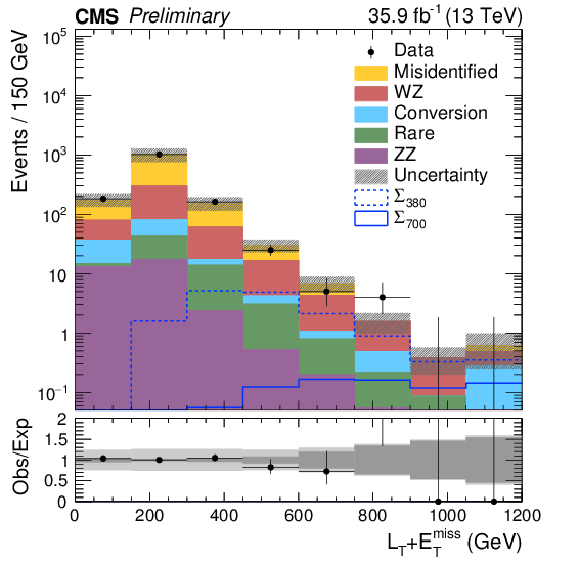
png pdf |
Figure 2-c:
The LT+EmissT distribution for events with three leptons and one OSSF pair, with mass below-Z and EmissT> 50 GeV. The total SM background is shown as a stack of all contributing processes. The predictions for signal models with mΣ= 700 GeV (solid line) and mΣ= 380 GeV (dashed line) (sum of all production and decay modes) are also shown. The hatched gray band in the upper panel, and the dark and light gray bands in the lower panel represent the total, statistical, and systematic uncertainties on the expected background, respectively. |

png pdf |
Figure 2-d:
The LT+EmissT distribution for events with three leptons and no OSSF pairs. The total SM background is shown as a stack of all contributing processes. The predictions for signal models with mΣ= 700 GeV (solid line) and mΣ= 380 GeV (dashed line) (sum of all production and decay modes) are also shown. The hatched gray band in the upper panel, and the dark and light gray bands in the lower panel represent the total, statistical, and systematic uncertainties on the expected background, respectively. |
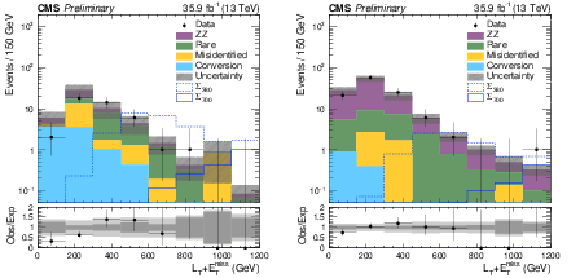
png pdf |
Figure 3:
The LT+EmissT distribution for events with four or more leptons and one OSSF pair (left), and with four or more leptons and at least two OSSF pairs (right). The total SM background is shown as a stack of all contributing processes. The predictions for signal models with mΣ= 700 GeV (solid line) and mΣ= 380 GeV (dashed line) (sum of all production and decay modes) are also shown. The hatched gray band in the upper panel, and the dark and light gray bands in the lower panel represent the total, statistical, and systematic uncertainties on the expected background, respectively. |
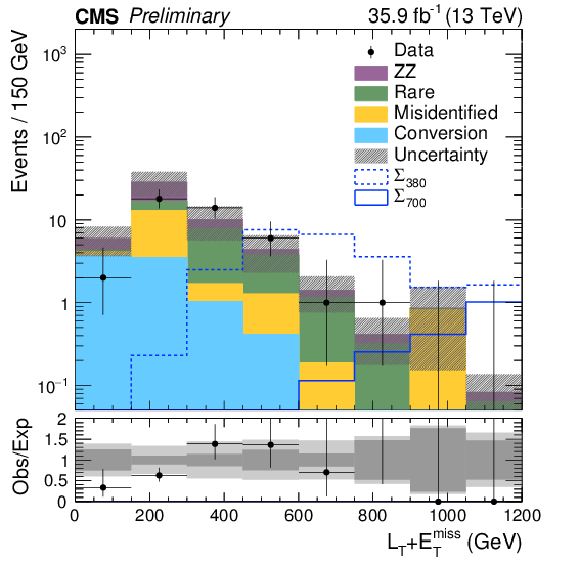
png pdf |
Figure 3-a:
The LT+EmissT distribution for events with four or more leptons and one OSSF pair. The total SM background is shown as a stack of all contributing processes. The predictions for signal models with mΣ= 700 GeV (solid line) and mΣ= 380 GeV (dashed line) (sum of all production and decay modes) are also shown. The hatched gray band in the upper panel, and the dark and light gray bands in the lower panel represent the total, statistical, and systematic uncertainties on the expected background, respectively. |
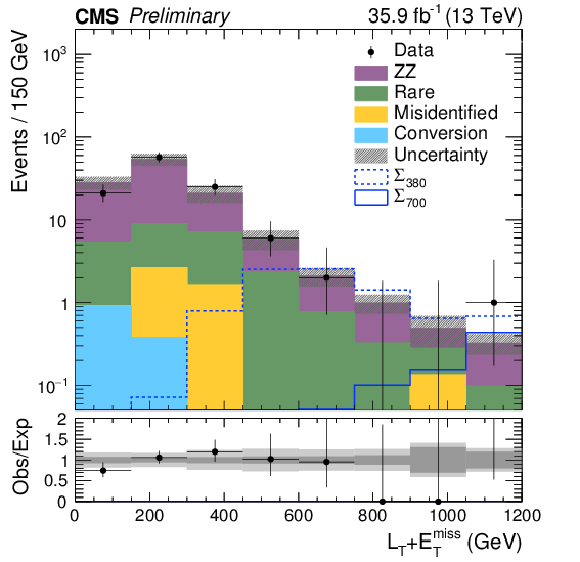
png pdf |
Figure 3-b:
The LT+EmissT distribution for events with four or more leptons and at least two OSSF pairs. The total SM background is shown as a stack of all contributing processes. The predictions for signal models with mΣ= 700 GeV (solid line) and mΣ= 380 GeV (dashed line) (sum of all production and decay modes) are also shown. The hatched gray band in the upper panel, and the dark and light gray bands in the lower panel represent the total, statistical, and systematic uncertainties on the expected background, respectively. |

png pdf |
Figure 4:
The 95% confidence level upper limits on the cross section sum for production of heavy fermion pairs (Σ0Σ+, Σ0Σ−, or Σ+Σ−). In the flavor-democratic scenario, we rule out heavy fermion pair production for masses below 850 GeV (expected 790 GeV). |
| Tables | |

png pdf |
Table 1:
The signal regions used in this search are summarized in terms of the number of leptons, the presence of an OSSF pair, and the kinematic variable used for discrimination. Each selection described here is further divided into eight bins in the kinematic variable, giving a total of 48 statistically independent signal regions. Additional criteria used to ensure that signal regions are non-overlapping with control regions are also stated. |
| Summary |
| In summary, we performed a search for type-III seesaw heavy fermions in multilepton final states using 35.9 fb−1 of proton-proton collision data at √s= 13 TeV, collected using the CMS detector. We observe no significant discrepancies between the background prediction and the data. Assuming degenerate heavy fermion masses mS, we exclude previously unexplored regions of the signal model with heavy fermion particle with a mass limit for the lepton-flavor democratic scenario of 850 GeV at 95% confidence level. |
| References | ||||
| 1 | F. Capozzi et al. | Status of three-neutrino oscillation parameters, circa 2013 | PRD 89 (2014) 093018 | 1312.2878 |
| 2 | P. Minkowski | μ→eγ at a rate of one out of 109 muon decays? | PLB 67 (1977) 421 | |
| 3 | M. Gell-Mann, P. Ramond, and R. Slansky | Neutrino Mass in seesaw type I | Sanibel Talk CALT-68-709 (1979) | |
| 4 | T. Yanagida | Neutrino Mass in seesaw type I | Proc. of the Workshop on Unified Theory and Baryon Number of the Universe 64 (1979) 1103 | |
| 5 | R. Mohapatra, N. Rabindra, and G. Senjanovic | Neutrino Mass and Spontaneous Parity Violation | PRL 44 (1980) 912 | |
| 6 | M. Magg and C. Wetterich | Neutrino Mass Problem and Gauge Hierarchy | PRB 94 (1980) 61 | |
| 7 | R. Mohapatra and G. Senjanovic | Neutrino Masses and Mixings in Gauge Models with Spontaneous Parity Violation | PRD 23 (1981) 165 | |
| 8 | E. Ma and U. Sarkar | Neutrino masses and leptogenesis with heavy Higgs triplets | PRL 80 (1998) 5716--5719 | hep-ph/9802445 |
| 9 | R. Foot, H. Lew, X. He, and G. Joshi | See-saw neutrino masses induced by a triplet of leptons | Z. Phys. C 44 (1989) | |
| 10 | R. N. Mohapatra | Mechanism for understanding small neutrino mass in superstring theories | PRL 56 (Feb, 1986) 561--563 | |
| 11 | R. N. Mohapatra and J. W. F. Valle | Neutrino mass and baryon-number nonconservation in superstring models | PRD 34 (Sep, 1986) 1642--1645 | |
| 12 | W.-Y. Keung and G. Senjanovi\ifmmode \acutec\else \'c\fi | Majorana Neutrinos and the Production of the Right-Handed Charged Gauge Boson | PRL 50 (May, 1983) 1427 | |
| 13 | R. Foot, H. Lew, X. He, and G. Joshi | See-saw neutrino masses induced by a triplet of leptons | Z. Phys. C 44 (1989) | |
| 14 | F. del Aguila and J. A. Aguilar-Saavedra | Distinguishing seesaw models at LHC with multi-lepton signals | Nucl. Phys. B813 (2009) 22--90 | 0808.2468 |
| 15 | F. del Aguila, J. A. Aguilar-Saavedra, and J. de Blas | Trilepton signals: the golden channel for seesaw searches at LHC | Acta Phys. Polon. B40 (2009) 2901--2911 | 0910.2720 |
| 16 | C. Biggio and F. Bonnet | Implementation of the type III seesaw model in FeynRules/MadGraph and prospects for discovery with early LHC data | Eur. Phys.J. C 72 (2012) 1899 | 1107.3463v3 |
| 17 | J. Alwall et al. | The automated computation of tree-level and next-to-leading order differential cross sections, and their matching to parton shower simulations | JHEP 07 (2014) 079 | 1405.0301 |
| 18 | CMS Collaboration | Search for heavy lepton partners of neutrinos in proton-proton collisions in the context of the type III seesaw mechanism | PLB718 (2012) 348 | CMS-EXO-11-073 1210.1797 |
| 19 | CMS Collaboration | Search for heavy lepton partners of neutrinos in pp collisions at 8 TeV, in the context of type III seesaw mechanism | CMS-PAS-EXO-14-001 | CMS-PAS-EXO-14-001 |
| 20 | ATLAS Collaboration | Search for type-III Seesaw heavy leptons in pp collisions at 8 TeV with the ATLAS Detector | PLD 92 (2015) 032001 | 1506.01839 |
| 21 | CMS Collaboration | Search for Type-III Seesaw Heavy Fermions with Multilepton Final States using 2.3 fb−1 of 13 TeV proton-proton Collision Data | CMS-PAS-EXO-16-002 | CMS-PAS-EXO-16-002 |
| 22 | CMS Collaboration | The CMS experiment at the CERN LHC | JINST 3 (2008) S08004 | CMS-00-001 |
| 23 | J. Alwall et al. | MadGraph 5 : Going Beyond | JHEP 06 (2011) 128 | 1106.0522 |
| 24 | NNPDF Collaboration | Parton distributions for the LHC Run II | JHEP 04 (2015) 040 | 1410.8849 |
| 25 | B. Fuks, M. Klasen, D. R. Lamprea, and M. Rothering | Gaugino production in proton-proton collisions at a center-of-mass energy of 8 TeV | JHEP 1210 (2012) 081 | 1207.2159v2 |
| 26 | B. Fuks, M. Klasen, D. R. Lamprea, and M. Rothering | Precision predictions for electroweak superpartner production at hadron colliders with Resummino | EPJC 73 (2013) 2480 | 1304.0790v2 |
| 27 | P. Nason | A New method for combining NLO QCD with shower Monte Carlo algorithms | JHEP 11 (2004) 040 | hep-ph/0409146 |
| 28 | S. Frixione, P. Nason, and C. Oleari | Matching NLO QCD computations with Parton Shower simulations: the POWHEG method | JHEP 11 (2007) 070 | 0709.2092 |
| 29 | Y. Gao et al. | Spin determination of single-produced resonances at hadron colliders | PRD81 (2010) 075022 | 1001.3396 |
| 30 | S. Bolognesi et al. | On the spin and parity of a single-produced resonance at the LHC | PRD86 (2012) 095031 | 1208.4018 |
| 31 | I. Anderson et al. | Constraining anomalous HVV interactions at proton and lepton colliders | PRD89 (2014), no. 3, 035007 | 1309.4819 |
| 32 | A. V. Gritsan, R. Rontsch, M. Schulze, and M. Xiao | Constraining anomalous Higgs boson couplings to the heavy flavor fermions using matrix element techniques | PRD94 (2016), no. 5, 055023 | 1606.03107 |
| 33 | T. Sjostrand, S. Mrenna, and P. Z. Skands | PYTHIA 6.4 Physics and Manual | JHEP 05 (2006) 026 | hep-ph/0603175 |
| 34 | T. Sjostrand et al. | An Introduction to PYTHIA 8.2 | CPC 191 (2015) 159--177 | 1410.3012 |
| 35 | GEANT4 Collaboration | GEANT4: A Simulation toolkit | NIMA506 (2003) 250--303 | |
| 36 | CMS Collaboration | Particle-Flow Event Reconstruction in CMS and Performance for Jets, Taus, and MET | CDS | |
| 37 | M. Cacciari, G. P. Salam, and G. Soyez | The Anti-k(t) jet clustering algorithm | JHEP 04 (2008) 063 | 0802.1189 |
| 38 | CMS Collaboration | MET performance in 8 TeV data | CMS-PAS-JME-12-002 | CMS-PAS-JME-12-002 |
| 39 | CMS Collaboration | Measurement of the tˉt production cross section in the dilepton channel in pp collisions at √s= 7 TeV | JHEP 11 (2012) 067 | CMS-TOP-11-005 1208.2671 |
| 40 | T. Junk | Confidence Level Computation for Combining Searches with Small Statistics | NIMA434 (1999) 435--443 | hep-ex/9902006 |
| 41 | A. L. Read | Modified frequentist analysis of search results (the CLs method) in ``Workshop on Confidence Limits'', Eds. F. James, L. Lyons, and Y. Perrin | p. 81 | |
| 42 | A. L. Read | Presentation of search results: The CL(s) technique | JPG 28 (2002) 2693 | |
| 43 | ATLAS and CMS Collaborations | Procedure for the LHC Higgs boson search combination in summer 2011 | Technical Report CMS NOTE-2011/005, ATL-PHYS-PUB-2011-11 | |

|
Compact Muon Solenoid LHC, CERN |

|

|

|

|

|

|